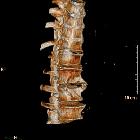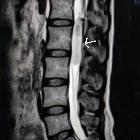vertebral scalloping
Vertebral scalloping is a concavity to the posterior (or less commonly anterior) aspect of the vertebral body when viewed in a lateral projection. A small amount of concavity is normal, as is concavity of the anterior vertebral body (see vertebral body squaring).
Posterior scalloping
Causes of posterior scalloping include the following, organized by mechanism :
- localized increased intraspinal pressure due to
- intradural spinal mass
- ependymoma, most commonly myxopapillary ependymoma
- astrocytoma
- paraganglioma
- neurofibroma as seen in neurofibromatosis type 1
- schwannoma
- lipoma
- intraspinal cysts
- intradural spinal mass
- dural ectasia
- neurofibromatosis type 1, especially with lateral thoracic meningocele
- hereditary connective tissue disorders
- congenital skeletal disorders
- achondroplasia due to small spinal canal
- mucopolysaccharidoses
- acromegaly
A useful mnemonic can be found here.
Anterior scalloping
Causes of increased anterior scalloping include:
- retroperitoneal lymphadenopathy, including (but not limited to):
- chronic leukemia
- lymphoma
- tuberculosis
- abdominal aortic aneurysm
- Down syndrome
Siehe auch:
- Tuberkulose
- Ependymom
- Neurofibromatose Typ 1
- Bauchaortenaneurysma
- Achondroplasie
- Ehlers-Danlos syndrome
- Akromegalie
- Marfan-Syndrom
- spinal paraganglioma
- spinale Schwannome
- Duraektasie
- Mukopolysaccharidose
- vertebral body squaring
- spinales Ependymom des Filum terminale
- spinales Astrozytom
- Osteogenesis imperfecta Typ 1
- Achondroplasie Wirbelsäule
und weiter:
 Assoziationen und Differentialdiagnosen zu scalloping Wirbelkörper:
Assoziationen und Differentialdiagnosen zu scalloping Wirbelkörper:

























